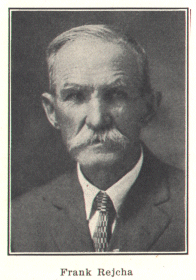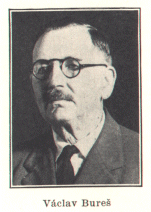 |
Schools(Part 2) |
This is a NEGenWeb Project web page
and is presented as part of the
MARDOS Memorial Library Collection.
Schools
(Part 2)
|
The Komensky Clubs (named for Jan Amos Komensky, or Comenius, the pioneer educator) were founded during the Christmas vacation l903 by Prof. Bohumil Simek of the State University of Iowa and F J. Pipal, a student of the Nebraska University. Mr. Pipal later became a professor in the Purdue University, Lafayette, Indiana, and now lives in Humboldt, Nebr. Upon his return to school, after vacation, in January 1904, Mr. Pipal and a group of twelve students met and founded the Komensky Educational Clubs. According to the constitution, any club or society of an educational or cultural nature was entitled to membership upon taking the name Komensky Educational Club and the aim was to help all clubs enrolled in educational effort, which was to form a bond among Czech-Americans. Further, Czech language and songs were to be perpetuated, Czech history and literature studied, the social condition of our people here, mentally and morally, was to be improved, and Americans were to be informed of whatever meritorious endeavors were undertaken by Czechs. The first step taken in this direction was to request the regents of the Nebraska State University to establish a Department of Slavonic Languages and Literature, but this request was refused, on the grounds that there was not enough public interest among Czechs to warrant it. The students were not discouraged and began to prepare the way by forming clubs. The first was that in Lincoln, No. 1. No. 2 was founded in South Omaha, June 1904, by Joseph V. Sterba (now a physician in Chicago) and Mr. Pipal. Club No. 3 was formed in Omaha, January 1905, but when some of the leading members, among them S. L. Kostohryz, F. J. Kutak, Rev. Jar. W. Dobias and V. Miniberger left the city, it disbanded and the club formed later in Iowa City, Iowa, by Jeffrey D. Hrbek, took No. 3 for its number. In the meantime agitation for the Slavonic Department continued. During the winter of 1906 and 1907 John Rosicky and Vaclav Bures of Omaha planned to make a new request. They were present at the meeting of the regents February 15, 1907, together with Frank Rejcha, a pioneer of Lancaster County and at the time a member of the state legislature. Rosicky made his plea and spoke of the history of Bohemia and John Amos Comenius, the great educator. Bures told how the Austrian government had tried to Germanize the Czechs in the past, and Rejcha made his plea on behalf of the large number of Czechs living in Nebraska. Chancellor Andrews replied that financial conditions would not permit this new expenditure. He said however, that if Rejcha would help the passage of the bill allowing one mill of the entire state tax for the state university, the Slavonic Department might materialize. 
Rosicky then cautioned Rejcha to do his best. The Omaha delegation was putting through the so-called "Terminal Taxation Bill", relating to the taxation of railroad properties and the railroads and their lobbyists of course wanted to kill the bill. The struggle lasted six weeks. The Lincoln Daily Star published a cartoon, showing Frank Rejcha as an old, cross man, with the caption: ''Frank Rejcha is watching the lobbyists and grafters". On March 24, 1907, at half after three, the voting began. The railroads schemed to keep the number not over 45 votes. Rejcha asked the help of Victor Rosewater, who was there as reporter for his Daily Bee, and who agreed to call a meeting (the previous evening) of the Douglas County delegation numbering nine. A member named Harvey bargained with Rejcha, if he would vote against the railroads, he (Harvey) would vote for the mill levy. Rejcha had secretly obtained ten votes and finally the levy bill, which meant the Slavonic Department, passed by 56 votes, the Terminal Bill by 55 votes. Of course those who worked for the railroads were chagrined, but Rejcha told them he was there in the interest of the people and not for corporations. It seemed then, that the Slavonic Department was assured, but governor Sheldon, who was preparing his way for a second term, reduced the expense estimate by $80,000 and Chancellor Andrews again did not see his way clear to grant the request for a Department of Slavonic languages, in spite of the appeals of Rosicky and Bures. He went abroad and Bures cabled the request anew and this time it was granted. Frank Rejcha was born August 13, 1858 in Belejsov, near Chudenice, County Klatovy. He came to Michigan in 1876, in March 1877 to Nebraska, where he worked at first on the farms of Frank Jelinek and Vaclav Sestak, Saline county pioneers. In 1879 he bought railroad land in Lancaster County and in December of that year married Anna Chrastil, daughter of a Lancaster County pioneer. Mrs. Rejcha died in 1925 and Mr. Rejcha now lives in Wilber, Nebr., where he is serving his fourth term as member of the Town Board. During his time in the legislature there was but one other Bohemian member, but he did nothing for the cause. 
Vaclav Bures, who with Rejcha and Rosicky, endeavored to have the department established, was born in Vosecek, Bohemia, Nov. 28, 1859, his father being John Bures. When four years old he became an orphan. He came to this country, to Iowa, in 1863, attended school in winter and worked on farms in summer. At the age of nineteen years he began to attend Western College, then an academy in Iowa City, and later for two years the Iowa State University. He then worked in stores and later moved to Rockford, Iowa. February 18, 1884 he married Miss Jennie B. Letovsky, of Iowa City, daughter of John Barta Letovsky who with Francis Korizek published the first Czech paper in this country, the Slovan Amerikansky of Racine (which later was changed to Slavie) and who for years published the Slovan Americky in Iowa City, Ia. In August 1886 Bures and family moved to Omaha, where at first he engaged in business, then was deputy in the office of county and city treasurers. In 1900 he helped to form the company that took over the publishing of the Pokrok Zapadu. His activities along these lines are given in the history of that paper, under the title of "Publications". In 1901 he was a member of our state legislature, as representative, republican. At present he lives in Los Angeles, Calif. In the fall of 1907 Jeffrey Dolezal Hrbek became professor of the new department. He was the youngest son of Joseph and Barbara (Dolezal) Hrbek and was born in Cedar Rapids, Iowa, August 21, 1882. His parents were among the early settlers of Iowa, having come to the valley of the Cedar River in the early sixties. Mrs. Hrbek was left a widow in 1887, with five children. Jeffrey early displayed unusual powers of mind. He attracted the attention of his teachers and in high school came under the influence of Miss Mary G. McClenahan, who encouraged his poetic talent and to whose memory he dedicated the class poem "Where Brook And River Meet", written at his graduation from Washington High School. At that time he began writing verse and through his efforts "The Pulse", a literary magazine,. was established. He was first editor. After leaving high school he taught in the public schools of Cedar Rapids and in 1902--3 entered Lafayette College, Easton, Pa., where he gained distinction in literary and language studies. He
Prof. Hrbek was succeeded by his sister, Prof. Sarka B. Hrbkova, whose biography is given at the close of the chapter on publications. During the World War, when many activities were disrupted, the Department of Slavonic was abolished and Prof. Hrbkova left our state in 1919. When the State Constitutional Convention was in session (1919--1920) two members thereof, C. V. Svoboda (Howard County) and Joseph T. Votava (Douglas County), conferred with Chancellor Avery about the reinstitution of teaching of Czech. The Chancellor had no objections provided the proper teacher could be found. It was agreed to have a conference with the other Czech delegates to this convention (Messrs. E. J. Spirk of Saline County, E. A. Coufal of Butler and Frank Malicky of Gage) with Chancellor Avery and Dean Buck. At that time the Chancellor explained that he knew the right person, Orin Stepanek. This was satisfactory to the delegation and the Chancellor agreed to cable Mr. Stepanek, who was in Europe at the time. Thus Prof. Stepanek entered upon his duties in the fall of 1920, when teaching of Czech was resumed under the Department of Modern Languages. At present it is being offered under the Department of Romance Languages. Prof. Orin Stepanek was born in Crete, Saline County, Nebraska. He graduated from the University of Nebraska with Phi Beta Kappa honors in 1913. The following year he received the degree of Master of Arts at Harvard University, winning a scholarship for that No. 1, Lincoln, Nebraska. Thus it will be seen that these clubs, which had their inception in our state, began to spread all over the United States. The clubs that formed the nucleus of this organization, as an association, were Clubs Nos. 1, 2, 3, 4, 5, 6 and 7 and the Association was formed in Cedar Rapids, Iowa, January 1, 1908. In August (28--30) 1914 a convention was held in Chicago, when a constitution was compiled and accepted. Charles Smrha (a banker living now in Milligan, Nebraska) presided, Ferdinand L. Musil was secretary and Dr. Fr. J. Jirka (Chicago), Mrs. B. Mekota (Cedar Rapids, Iowa), Frank Hrdy (Milligan, Nebr.), Vaclav Bures (Omaha, Neb.) and Joseph V. Sterba (Chicago) were on the constitution committee. The following officers were elected: Jos. V. Sterba, Chicago, president; Miss Emily Krisl, Lincoln, Neb., vice-president; Miss Millie E. Suster, Chicago, secretary and Ferdinand L. Musil, Chicago, treasurer. In 1917, June 29 to July 1st, the sixth and last convention was held in Omaha, Nebraska, the following clubs being represented: Nos. 1, 2, 9, 13, 14, 23, 24, 28, --all from Nebraska except No. 14 (Texas). Mr. Joseph V. Sterba presided, Miss Libbie Breuer (now Mrs. Harry C. Scholten of Gilroy, California) was vice-president, Misses Vlasta Sterba and Bozena Fitl, secretaries. The last publication of the Komensky Magazine was issued in December 1918, and the clubs suspended activity. Young men had to enlist, all foreign-language clubs and movements were considered more or less un-American, money ceased to come in, and with great difficulty enough was collected to pay for the last issue. It is to be regretted that an organization of such high aims should not have flourished, but this seems to be the fate of all foreign-language efforts in this country, sooner or later. A number of clubs still are in existence, but the movement, as a whole, has lost its vigor. There is still on hand, in charge of the treasurer, the sum of $1970.00 in funds gathered for building a monument to Komensky (Jan Amos Comenius) and it is hoped that this will materialize at no far date. |
| Back | Table of Contents | Next |